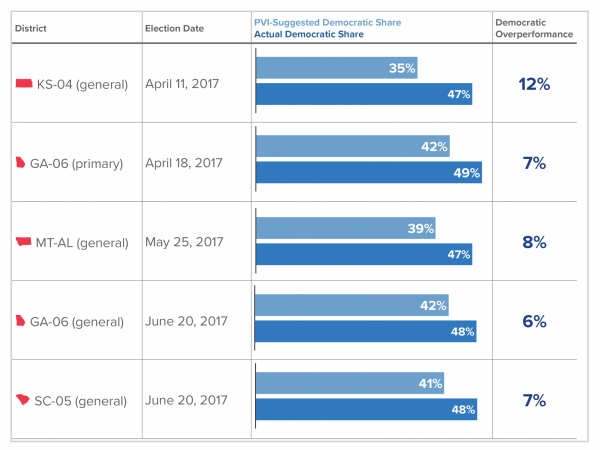
It's a devastating psychological blow for a party to spend over $30 million on a House special election and still lose. For Democrats, Jon Ossoff's defeat to Karen Handel stings, and the blame game is already raging: "Why did Ossoff run such a bland campaign? Why didn't he take a sledgehammer to Trump and the AHCA? Don't Democrats need to recruit little league coaches with deeper ties to their communities?"
This kind of second-guessing is a bit misguided. Last night's results were far from a disaster for Democrats, and Republicans shouldn't be tempted to believe their House majority is safe. In fact, their majority is still very much at risk.
First and foremost, just one state over, unheralded Democratic tax expert Archie Parnell - who ran on a similarly conciliatory, post-partisan message but generated a tiny fraction of the hype Ossoff did - shockingly came within three points of Republican Ralph Norman in a district President Trump carried by 18 points last November (Ossoff came within four points in a district Trump carried by one).
Parnell's near-miss has prompted outrage from activists on the left who believe he got short shrift from the DNC, DCCC and party hierarchy. If only the DCCC had parachuted into Sumter instead of Atlanta, the thinking goes, Democrats might have actually gained a House seat by now. But the reality is Parnell - much like Democrat James Thompson in KS-04 - outperformed polls and expectations precisely because the race flew under the radar, not despite it.
The divergent results in GA-06 and SC-05 prove saturation-level campaigns can backfire on the party with a baseline enthusiasm advantage - in this case, Democrats. The GA-06 election drew over 259,000 voters - an all-time turnout record for a stand-alone special election and an amazing 49,000 more than participated in the 2014 midterm in GA-06. The crush of attention motivated GOP voters who might have otherwise stayed home, helping Handel to victory.
Credit must be given to the NRCC and the House GOP leadership-allied Congressional Leadership Fund, who did more with less and ran straightforward but effective ads to buttress Handel's imperfect campaign and neutralize Ossoff's enormous advantage on the airwaves. Trump's approval rating in GA-06 was still mired in the low 40s by this week, but the GOP was still able to compound and capitalize on serious Ossoff fatigue.
By contrast, SC-05 drew fewer than 88,000 voters despite its similar population. Norman, the Republican nominee, had just emerged from a tight runoff with critical backing from the Club for Growth, but had alienated some of the district's chamber of commerce types. Meanwhile, Parnell benefited from a base of highly motivated Democrats, including a modest and low-profile DCCC effort to turn out African-American voters.
The good news for Republicans is that swarms of national media and images of Nancy Pelosi still motivate their base. The bad news for Republicans is that they can't count on this type of high turnout across the board in November 2018. In fact, it would be shocking if any House race drew a third of the $55 million spent on the GA-06 special election. And that means Democrats' enthusiasm edge should be wider in most places than it was in GA-06.
Second, overhyped special elections can often be lagging - rather than leading - indicators. In June 2006, Republicans retained a San Diego seat in a very expensive special election five months before losing the House. In May 2010, Democrats held an ancestrally Democratic seat in southwestern Pennsylvania six months before losing their majority. For a moment, tradition held. Today, both those seats are represented by the opposite party.
Third, believe it or not, GA-06 wasn't the only special election held this year. Although it's true Democrats have agonizingly yet to capture a red district, they have outperformed their "generic" share of the vote significantly in every contest. Measured against the Cook Political Report's Partisan Voter Index (PVI), Democrats have outperformed the partisan lean of their districts by an average of eight points in the past five elections:
A Smarter Way to Interpret 2017's Special Elections

If Democrats were to outperform their "generic" share by eight points across the board in November 2018, they would pick up 80 seats. Of course, that won't happen because Republican incumbents will be tougher to dislodge than special election nominees. But these results fit a pattern that should still worry GOP incumbents everywhere, regardless of Trump's national approval rating and the outcome of the healthcare debate in Congress.
Put another way, Democratic candidates in these elections have won an average of 68 percent of the votes Hillary Clinton won in their districts, while Republican candidates have won an average of 54 percent of Trump's votes. That's an enthusiasm gap that big enough to gravely imperil the Republican majority next November - even if it didn't show up in "the special election to end all special elections," GA-06.

Subscribe Today
Our subscribers have first access to individual race pages for each House, Senate and Governors race, which will include race ratings (each race is rated on a seven-point scale) and a narrative analysis pertaining to that race.